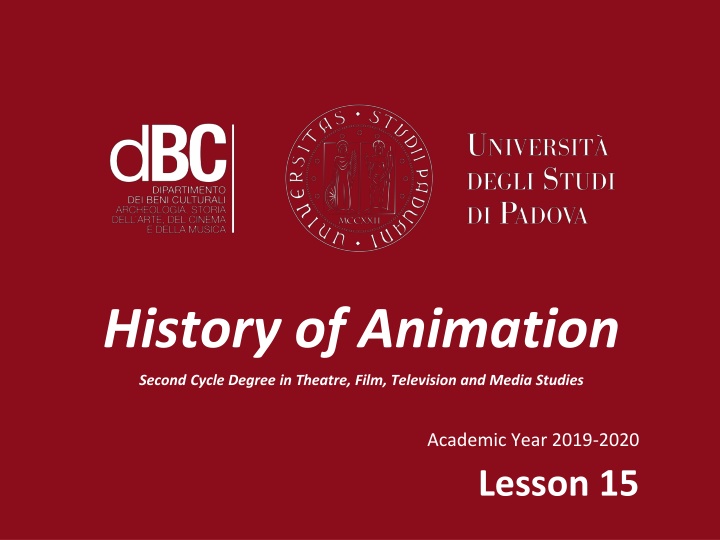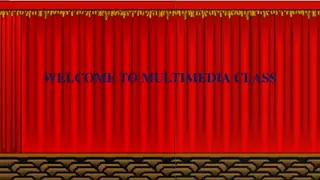
Animation History in Eastern Europe: Czechoslovakia's Pioneers
Explore the rich history of animation in Eastern Europe, focusing on Czechoslovakia and its notable pioneers. From the influence of Stalinism to the unique blend of live action and animation, discover the evolution of this art form in the region. Dive into the works of Karel Zeman and Jiří Trnka, who made significant contributions to the Czechoslovakian animation industry.
Download Presentation

Please find below an Image/Link to download the presentation.
The content on the website is provided AS IS for your information and personal use only. It may not be sold, licensed, or shared on other websites without obtaining consent from the author. If you encounter any issues during the download, it is possible that the publisher has removed the file from their server.
You are allowed to download the files provided on this website for personal or commercial use, subject to the condition that they are used lawfully. All files are the property of their respective owners.
The content on the website is provided AS IS for your information and personal use only. It may not be sold, licensed, or shared on other websites without obtaining consent from the author.
E N D
Presentation Transcript
History of Animation Second Cycle Degree in Theatre, Film, Television and Media Studies Academic Year 2019-2020 Lesson 15
Animation in Europe 4 Schools and authors of Eastern Europe
Animation in Europe 4 Before 1989, East European countries suffered the influence of Stalinism. The only possible cinema was a state-funded one. Censorship and socialist realism forced animators to avoid references to avant-garde movements. Their inspiration mostly came from harmless sources, such as folk songs, legends and fairy tales. However, as the influence of Stalinism faded away, East European animation tackled also social and political issues.
Animation in Europe 4 Czechoslovakia Czechoslovakia Since the 1930s, the most important Czechoslovakian studios were in Prague. Karel Dodal established in 1935 (The Lantern s secret) a longstanding tradition of puppet animation of this country. In the same year, a studio was founded in Prague: AFIT (Atelier Filmovych Triku). It provided special effects for live-action films; during the World War II it was confiscated and managed by nazis.
Animation in Europe 4 Czechoslovakia After animators were ready to start their careers. In 1945, Jir Trnka renamed the Prague studio Bratri v triku ( The brothers in shirt or The brothers of tricks ). the liberation, many young
Animation in Europe 4 Czechoslovakia Karel Zeman (1910-1989) He started from puppet animation (Inspirace, 1948); his best works, however, feature a unique and pictorial mix-up of live action and animations, as seen in the films Vyn lez zkazy (The Diabolic Invention, 1958) and Baron Pr sil (Baron M nchhausen, 1961).
Animation in Europe 4 Czechoslovakia Inspirace (Karel Zeman, 1948)
Animation in Europe 4 Czechoslovakia The Diabolic Invention (Karel Zeman, 1958)
Animation in Europe 4 Czechoslovakia Ji Trnka (1912-1969) Trnka approached animation at the end of World War II. In his youth, he was a renowned illustrator of books for children, as well as a scene designer for the National Theatre in Prague. His main artistic interest, however, was puppetry: in his early youth, he assisted the foremost Czech puppeteer of the early 20th century, Josef Skupa; Trnka later founded an own puppet theatre in Prague, that was active from 1936 to 1937. Trnka was soon destined to become the most important director of Czech puppet films. At first he dealt with animated drawings (Darek, The Gift, 1946). palicek (The Czech Year, 1947) was his first puppet film.
Animation in Europe 4 Czechoslovakia At first an optimist, fascinated by fairy tales and legends (C saruv Slav k, The Emperor s Nightingale, 1948), Trnka produced his last full length feature in 1959: Sen noci svatoj sk (A Midsummer Night s Dream). In the 60s, however, he fell into a deep depression. This state of mind is clearly evident in Ruka (The Hand, 1965), his last short film: a sour satire on creative freedom.
Animation in Europe 4 Czechoslovakia C saruv Slav k (The Emperor s Nightingale, Ji Trnka, 1948)
Animation in Europe 4 Czechoslovakia Bajaja (Ji Trnka, 1950)
Animation in Europe 4 Czechoslovakia Ruka (The Hand, Jir Trnka, 1965)
Animation in Europe 4 The Zagreb School Yugoslavia: the Zagreb School The activity of the Zagreb School is commonly divided into two periods. The first (1957-1964) was marked by the establishment of limited, abstract hand-drawn animation and a preference of themes revolving around incommunicability and the drama of the human condition. The main directors were Du anVukoti (1923-1998), Vatroslav Mimica (1923) and Vlado Kristl (1923- 2004).
Animation in Europe 4 The Zagreb School Surogat (Du anVukoti , 1961)
Animation in Europe 4 The Zagreb School The second period of the Zagreb School started as, in 1963, all the main directors and animators emigrated or returned to live-action films. So, a new generation of young artists took their place. Individuality was favored over homogeneity; notwithstanding this preference for auteurs, the Zagreb School also produced TV series (as ProfessorBalthazar , by Zlatko Grgi , 1967-1974) and advertisements. During the 1980s, the Zagreb School faded away; however, animation spread to other cities of Yugoslavia, where is still vital.
Animation in Europe 4 The Zagreb School Satiemania (Zdenk Gasparovich, 1978)
Animation in Europe 4 Soviet animation Soviet animation Children s films were the main product of Soviet animation during the fifteen years that followed the end of World War II. The style was a Disney-like one, with cel animation, rounded designs and fairy tale subjects. The opening of a special animation section at Sojuzmultfilm favored a timid renewal (puppet animation and cut-outs started to be used again).
Animation in Europe 4 Soviet animation However, from the 40s to the 60s Soviet animation did not try to express social or political themes. Animators considered themselves good artists at the service of the audience, responsible for good entertainment and methodical teaching. The main authors from this period were Ivan ivanov- Vano, the Brumberg sisters, Lev Atamanov and Mikhail Tsekhanovsky.
Animation in Europe 4 Soviet animation The Snow Queen (Lev Atamanov, 1957)
Animation in Europe 4 Soviet animation Ballerina on a boat (Lev Atamanov, 1969)
Animation in Europe 4 Soviet animation The Little Humpbacked Horse (Ivan Ivanov-Vano, 1947)
Animation in Europe 4 Soviet animation Seasons (Ivan Ivanov-Vano, 1969)
Animation in Europe 4 Soviet animation The 60s brought more diversification among the Soviet animators. Satire and stylistic research became more common, even though there were no revolutionary tendencies. The most relevant Soviet animator of the decade was Fedor Khitruk. His first film, History of a Crime (1961) had an almost neorealist flavour. At the age of 20, in 1961, Yuri Norstein joined Sojuzmultfilm. His first film, The 25th: The First Day (1968) was a commemoration of the October Revolution, and it already showed a distinct directorial style.
Animation in Europe 4 Soviet animation Yuri Norstein would become one of the most respected animators in the world. He developed a complex mixed technique, mainly based on paper cut-outs; his vision of animation favours the enhancement of emotions and sensitivity. His stories are often free recollections of memories and experiences, both cultural and personal. His film The Tale of Tales (1979) has been twice awarded the title of Best Animated Film of All Time (Los Angeles, 1984, and Zagreb, 2002). It is the representation of a free flow of thought about childhood, coming to age and separation, as a metaphor of the relationship between artists and their creations. It is loosely inspired by a poem by Nazim Hikmet.
Animation in Europe 4 Soviet animation History of a Crime (Fedor Khitruk, 1961)
Animation in Europe 4 Soviet animation The Tale of Tales (Yuri Norstein, 1979)
Suggested readings Giannalberto Bendazzi, Animation. A World History. 3 voll., Waltham, Massachusetts: Focal Press, 2015. Vol. II, pp. 57-59 (only the section Czechoslovakia and Puppets ); Vol. II, pp. 60-68 (from and including- the section KarelZeman up to and including- the section The Music of the Puppets ). Vol. II, pp. 68-70 (section Yugoslavia: The First Stage of the Zagreb School ). Vol. II, pp. 262-273 (from and including- the section Yugoslavia: The New Zagreb School , up to and including- the section Otherartists ). Vol. II, pp. 76- 83 (from and including- the section Russia up to and including- the section Ivan Ivanov-Vano ). Vol. II, pp. 280-284 (from and including- the section Russia up to and including- the section Quality Hatches at Soyuzmultfilm ); Vol. II, pp. 294-297 (section Fedor Khitruk ); Vol. II, pp. 301-304 (section YuriNorstein ); Vol. II, pp. 309-311 (section More about it ).






















